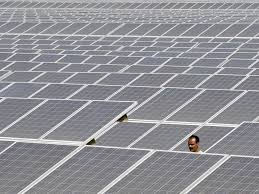Solar prices hit a new bottom, almost competitive with coal

Even as long as five years ago, Indian power industry experts would scoff about solar being a feasible source of power that could compete, price-wise, against fossil fuels, never mind issues about capacity utilization.

They would be more than a little irritated to learn that a few days ago, the state of Madhya Pradesh accepted the bid presented by HimgiriEnergy Ventures to supply solar power to the state grid at a rock bottom price of Rs 6.5 ($0.106) a unit, according to this article. Apparently, the price was 13 percent lower than the lowest price recorded to date in India, and a staggering 61 percent fall over the past three years. The most significant detail, of course, is that this price is just 14 percent above the thermal power pricing per unit of Rs 5.71 ($0.093).
This would be a tremendous development by itself, but when you consider the dire state of affairs within India's energy landscape, it becomes even more monumental. Today, India's energy consumption is only a fourth of the global average, so you can imagine what's going to happen when 60 percent of Indians finally climb out of poverty and the rest of urban India ramps up its consumption. Tack on a major push towards manufacturing, which this largely service economy will need to do to increase per capita income, and you've got a massive increase in projected power demand — and a serious shortfall.
By 2035, the BP Energy Outlook suggests that India will outstrip China as the largest source of energy demand growth in the world — a whopping 132 percent versus China's 71 percent, and double the aggregate of non-OECD countries — while its energy import bill in all likelihood will be around $300 billion.
Now, India can theoretically power itself with the large and abundant reserves of coal available. After all, at 293 billion tonnes, it has the fourth largest coal reserves in the world, and 10 percent of global deposits.
However, much of that coal is of poor quality or unmined, resulting in imports of over $15 billion, with the country still desperate for more. The country also has abundant gas reserves in the Krishna Godavari basin, but so far, Reliance Industries, having being commissioned to extract it, has spent the majority of its time arguing with the government about the price of gas it should be allowed to charge, rather than delivering it.
Meanwhile, state utilities are going bankrupt thanks to expensive coal imported from places like Indonesia and South Africa. All in all, India registered a peak power deficit of 11 percent, having lost 15.1 billion units of electricity due to a coal shortage. In other words, India is increasingly going to get import dependent without a significant change in its strategy. What it clearly needs is a "basket" of solutions, rather than just this or that.
So, it's easy to see why everyone was especially focused on the second round of the National Solar Mission, whose end goal is the building of 22,000MW of solar capacity by 2022. The last round saw bids that were three times the advertised requirement. Apparently, the increase in capacity is being fuelled by the new tariff, set at Rs 5.5 ($0.0901) per unit, with some assistance from the government in the form of "viability gap funding".
Feeding solar power to the national grid is all well and good, but the real revolution in India, as this article explains, is bringing light for the first time to rural parts of India that have been conveniently ignored since independence. Today, companies like Naturetech Infra's micro grids — of 150 watts (powering 20 households) to 5 kilo watt (40 households and commercial use like water pumps) — in backward villages in India's largest state of Uttar Pradesh gives families seven hours of power, enough to run two bulbs, one fan, and a mobile charging point for Rs 120, a bargain, considering the kind of impact it could have on their lives.
Of course, the caveat to all this solar euphoria is in monitoring whether these solar projects deliver in terms of the basic terms of agreement that were signed. Both parties have been flagrant defaulters in the past in India. State governments have reneged on the per unit price agreed upon before thanks to rapidly falling solar components, while there's been lots of talk that companies have and do underbid in order to snag contracts that they can re-jigger later.
For solar to have credibility as a reliable source of power in India, it needs to graduate to an accumulation of productive, stable projects that have replaced other forms of power. When that happens — and, who knows, it could in 10 or 20 years — with cheaper components and better capacity utilisation, solar may just become the only economically feasible option we have.